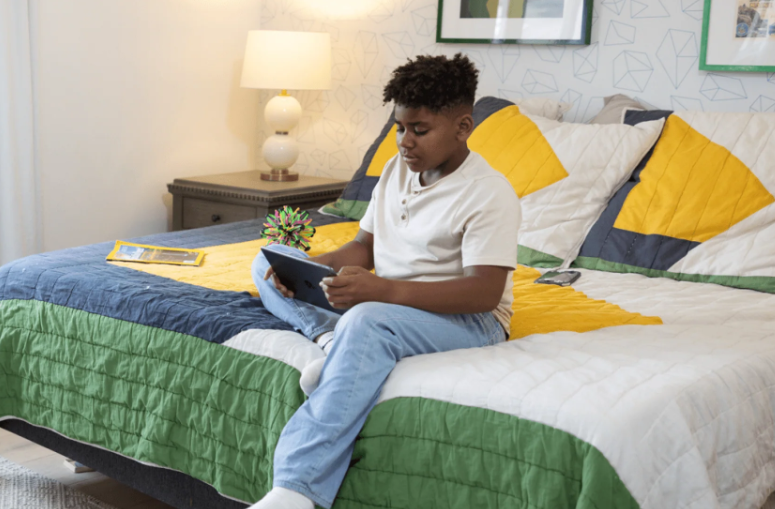Creating A Distraction-Free Homeschooling for children with ADHD can be immensely rewarding, but it presents unique challenges—especially when it comes to focus and attention.
An optimized homeschooling environment is one of the most critical factors for your child’s success.
By intentionally designing a distraction-free homeschooling space, you help minimize overstimulation, increase focus, and turn learning at home into a positive experience for your child.
Also Read: Tired of Getting Sick Every Time Your Kids Do? 7 Immune-Boosting Foods That Keep Moms Healthy

Understanding ADHD and the Distraction-Free Homeschooling Environment
ADHD is a neurological condition marked by difficulties with attention, impulsivity, and managing hyperactivity.
Standard classroom environments often struggle to support these needs, but this allows you to tailor both the environment and teaching pace for your child.
The core goal is to reduce distractions, support predictable routines, and create a nurturing homeschooling space that engages children with ADHD.
Why a Distraction-Free Homeschooling Space Matters
- Improves Focus: A structured homeschooling setup with minimal distractions helps ADHD learners stay engaged.
- Reduces Stress: A calm, orderly environment decreases sensory overload, a common challenge for ADHD children.
- Boosts Independence: Assigning a consistent workspace fosters responsibility and self-regulation.
Homeschooling experts highlight that small design changes in your environment can powerfully impact children with ADHD.
How to Design an ADHD-Friendly Homeschooling Environment
1. Choose the Best Location for Distraction-Free Homeschooling
- Quiet Areas: Pick a spot away from busy household traffic and loud noises for your space.
- Good Lighting: Natural or soft lighting improves alertness, but avoid glare in your setup.
- Flexible Spaces: Some homeschooling families benefit from being able to move lessons outdoors or into different rooms when needed.
2. Declutter and Simplify Your Homeschooling Workspace
- Minimal Surfaces: Keep only current materials out; store extra supplies away from sight.
- Simple Decor: Neutral colors and limited wall distractions can help centralize attention during homeschooling lessons.
- Organizers: Use bins, shelves, and drawers to keep resources neat and accessible.
3. Select Supportive Furniture for Homeschooling
- Ergonomic Seating: Choose stable chairs or seating that supports posture during homeschooling.
- Movement Options: For some ADHD children, integrating wobble stools, yoga balls, or standing desks into the homeschooling environment can help manage excess energy.
4. Reduce Homeschooling Distractions
- Sound Control: Use white noise machines, playlists, or noise-canceling headphones in your environment to minimize distractions.
- Fidget Tools: Quiet sensory fidgets allow hands to move during homeschooling without disrupting learning.
- Privacy Boards: Cardboard dividers or bookcases can create boundaries within the homeschooling space, reducing visual distractions.
5. Organize Homeschooling Materials and Structure
- Color Coding: Assign a color to each subject using bins or folders.
- Checklists: Visual schedules help homeschooled children anticipate daily tasks.
- Timers: Visual clocks or timers can provide clarity around homeschooling transitions and break periods.
Recommended ADHD-Friendly Distraction-Free Homeschooling Tools
| Tool/Supply | Purpose in Homeschooling |
| Noise-canceling headphones | Minimize auditory distractions during homeschooling |
| White noise machines | Create a consistent, soothing sound in the homeschooling area |
| Fidget toys (stress balls, bands) | Meet sensory needs in the homeschooling setting |
| Privacy dividers | Reduce visual clutter in the homeschooling workspace |
| Timers or visual clocks | Support transitions and time management in homeschooling |
| Organizational bins and labels | Promote a tidy, accessible homeschooling environment |
Real-Life Homeschooling Environment Examples for Kids with ADHD
- Minimalist Homeschooling Desk: A simple desk beside a window, containing just essentials like a lamp, workbook, and pencil cup, while all other homeschooling supplies are stowed in bins.
- Portable Homeschooling Cart: A rolling caddy with subject-mapped bins, ready to move wherever the homeschooling day leads.
- Homeschooling Sensory Corner: A small corner near the main workspace with a bean bag, sensory bin, or mini-trampoline for movement breaks.
Pro Tips for a Productive Distraction-Free Homeschooling Environment
- Incorporate Breaks: Schedule movement breaks between homeschooling activities to help with focus and energy.
- Use Multisensory Teaching: Vary instructional methods in your homeschooling setup with visual, tactile, and auditory material.
- Short Lessons: Opt for multiple brief homeschooling sessions (15–30 minutes) with regular pauses rather than marathon study periods.
- Consistent Routines: Even with flexibility, try to keep a predictably structured homeschooling schedule.
Frequently Asked Questions about Homeschooling Kids with ADHD
Q1: Is homeschooling suitable for children with ADHD?
Yes, homeschooling offers flexibility and personalized support, often leading to greater success and confidence for ADHD learners compared to traditional classrooms.
Q2: What’s the ideal lesson length for homeschooling kids with ADHD?
Short sessions of 15–30 minutes, matched to your child’s attention span, usually work best for homeschooling. Include activity breaks to reset focus.
Q3: What seating should I use in my homeschooling environment for an ADHD child?
Comfortable, supportive chairs are important, but some children benefit from options like wobble cushions or yoga balls as part of the homeschooling setup.
Q4: How can I handle distractions in a busy homeschooling home?
Noise-canceling headphones, designated quiet spaces, or even a carrel or divider can make a big difference in your homeschooling environment.
Q5: What’s the best way to organize homeschooling materials for ADHD learners?
Use color-coded folders, clear bins, visual checklists, and timers as part of your homeschooling system.
A distraction-free homeschooling environment tailored for a child with ADHD is a foundation for academic growth and emotional well-being.
The key is intentionality: organize, simplify, and equip your homeschooling space with tools and strategies that let your child’s strengths shine.
With the flexibility of homeschooling, you can adapt your environment for long-term focus and enjoyment.
References:
BJU Press: Homeschooling Children with ADHD
Time4Learning: How to Create a Homeschool Schedule for Kids with ADHD
